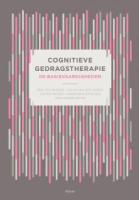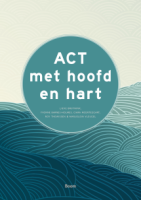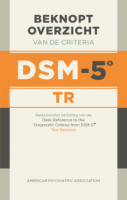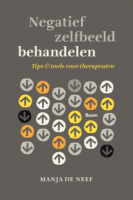Inhoud
Het glas is halfvol - Computerinterpretatietraining bij angst
Samenvatting
Angst hangt samen met de neiging om ambigue informatie negatief te interpreteren. Recent zijn er computergestuurde trainingen ontwikkeld waarmee een dergelijke negatieve interpretatiebias veranderd kan worden en, klinisch interessanter, waardoor ook angst vermindert. Veelbelovende effecten zijn gevonden bij zowel kinderen, adolescenten, en volwassenen en dit zowel in gezonde en klinische groepen, hetgeen deze interpretatiebias training interessant maakt voor preventie en interventie doeleinden.
Literatuur
- Amir, N., & Taylor, C.T. (2012). Interpretation training in individuals with generalized social anxiety disorder: A randomized controlled trial. Journal of Consulting and Clinical Psychology, 80, 497-511.
- Amir, N., Foa, E.B., & Coles, M.E. (1998). Negative interpretation bias in social phobia. Behaviour Research and Therapy, 36, 945-957.
- Amir, N., & Taylor, C.T. (2012). Combining computerized home-based treatments for generalized anxiety disorder: An attention modification program and cognitive behavioral therapy. Behavior Therapy, 43, 546-559.
- Baert, S., De Raedt, R., Schacht, R., & Koster, E.H.W. (2010). Attentional bias training in depression: Therapeutic effects depend on depression severity. Journal of Behavior Therapy and Experimental Psychiatry, 41, 265-274.
- Beck, A.T., Emery, G., & Greenberg, R.L. (1985). Anxiety disorders and phobias: A cognitive perspective. New York: Basic Books.
- Blackwell, S.E., & Holmes, E.A. (2010). Modifying interpretation and imagination in clinical depression: A single case series using cognitive bias modification. Applied Cognitive Psychology, 24, 338-350.
- Brosan, L., Hoppitt, L., Shelfer, L., Sillence, A., & Mackintosh, B. (2011). Cognitive bias modification for attention and interpretation reduces trait and state anxiety in anxious patients referred to an out-patient service: Results from a pilot study. Journal of Behavior Therapy and Experimental Psychiatry, 42, 258-264.
- Butler, G., & Mathews, A. (1983). Cognitive processes in anxiety. Advances in Behaviour Research and Therapy, 5, 51-62.
- Clark, D.M., Salkovskis, P.M., Ost, L.G., Breitholtz, E., Koehler, K.A., Westling, B.E., et al. (1997). Misinterpretation of body sensations in panic disorder. Journal of Consulting and Clinical Psychology, 65, 203-213.
- Clerkin, E.M., & Teachman, B.A. (2011). Training interpretation biases among individuals with symptoms of obsessive compulsive disorder. Journal of Behavior Therapy and Experimental Psychiatry, 42, 337-343.
- Dunmore, E., Clark, D.M., & Ehlers, A. (2001). A prospective investigation of the role of cognitive factors in persistent Posttraumatic Stress Disorder (PTSD) after physical or sexual assault. Behaviour Research and Therapy, 39, 1063–1084.
- Franklin, M.E., Huppert, J., Langner, R., Leiberg, S., & Foa, E.B. (2005). Interpretation bias: A comparison of treated social phobics, untreated social phobics, and controls. Cognitive Therapy and Research, 29, 289-300.
- Hakamata, Y., Lissek, S., Bar-Haim, Y., Britton, J.C., Fox, N.A., Leibenluft, E., et al. (2010). Attention bias modification treatment: A meta-analysis toward the establishment of novel treatment for anxiety. Biological Psychiatry, 68, 982-990.
- Hayes, S., Hirsch, C.R., Krebs, G., & Mathews, A. (2010). The effects of modifying interpre tation bias on worry in generalized anxiety disorder. Behaviour Research and Therapy, 48, 171-178.
- Hofmann, S.G., Meuret, A.E., Rosenfield, D., Suvak, M.K., Barlow, D.H., Gorman, J.M., et al. (2007). Preliminary evidence for cognitive mediation during cognitive-behavioral therapy of panic disorder. Journal of Consulting and Clinical Psychology, 75, 374-379.
- Lester, K.J., Field, A.P., & Muris, P. (2011). Experimental modification of interpretation bias about animal fear in young children: Effects on cognition, avoidance behavior, anxiety vulnerability, and physiological responding. Journal of Clinical Child and Adolescent Psychology, 40, 864-877.
- Lothmann, C., Holmes, E.A., Chan, S.W.Y., & Lau, J.Y.F. (2010). Cognitive bias modification training in adolescents: Effects on interpretation biases and mood. The Journal of Child Psychology and Psychiatry, 52, 24-32.
- Mackintosh, B., Mathews, A., Yiend, J., Ridgeway, V., & Cook, E. (2006). Induced biases in emotional interpretation influence stress vulnerability and endure despite changes in context. Behavior Therapy, 37, 209-222.
- Mathews, A., & Mackintosh, B. (2000). Induced emotional interpretation bias and anxiety. Journal of Abnormal Psychology, 109, 602-615.
- McGowan, N., Sharpe, L., Refshauge, K., & Nicholas, M. (2009). The effect of attentional re-training and threat expectancy in response to acute pain. Pain, 142, 101-107.
- Miers, A.C., Blöte, A.W., Bögels, S.M., & Westenberg, P.M. (2008). Interpretation bias and social anxiety in adolescents. Journal of Anxiety Disorders, 22, 1462-1471.
- Muris, P., Huijding, J., Mayer, B., & Hameetman, M. (2008). A space odyssey: Experimental manipulation of threat perception and anxiety-related interpretation bias in children. Child Psychiatry and Human Development, 39, 469-480.
- Murphy, R., Hirsch, C.R., Mathews, A., Smith, K., & Clark, D.M. (2007). Facilitating a benign interpretation bias in a high socially anxious population. Behaviour Research and Therapy, 45, 1517-1529.
- Prins, P.J.M., Dovis, S., Ponsioen, A., Brink, E. ten, & Oord, S. van der (2010). Does a computerized working memory training with game elements enhance motivation and training efficacy in children with adhd? Cyberpsychology and Behavior, E-pub July.
- Pury, C.L.S. (2002). Information-processing predictors of emotional response to stress. Cognition and Emotion, 16, 667-683.
- Salemink, E., Hout, M.A. van den, & Kindt, M. (2007). Trained interpretive bias: Validity and effects on anxiety. Journal of Behavior Therapy and Experimental Psychiatry, 38, 212-224.
- Salemink, E., Hout, M.A. van den, & Kindt, M. (2009). Effects of positive interpretive bias modification in highly anxious individuals. Journal of Anxiety Disorders, 23, 676-683.
- Salemink, E., & Wiers, R.W. (2011). Modifying threat-related interpretive bias in adolescents. Journal of Abnormal Child Psychology, 39, 967-976.
- Schoenmakers, T.M., Bruin, M. de, Lux, I.F.M., Goertz, A.G., Kerkhof, D.H.A T. van, & Wiers, R.W. (2010). Clinical effectiveness of attentional bias modification training in abstinent alcoholic patients. Drug and Alcohol Dependence, 109, 30-36.
- See, J., MacLeod, C., & Bridle, R. (2009). The reduction of anxiety vulnerability through the modification of attentional bias: A real-world study using a home-based cognitive bias modification procedure. Journal of Abnormal Psychology, 118, 65-75.
- Smeets, E., Jansen, A., & Roefs, A. (2011). Bias for the (un) attractive self: On the role of attention in causing body (dis) satisfaction. Health Psychology, 30, 360.
- Sportel, B.E., Hullu, E. de, Jong, P.J. de, & Nauta, M.H. (2013). Cognitive bias modification versus CBT in reducing adolescent social anxiety: a randomized controlled trial. PloS one, 8, e64355.
- Standage, H., Ashwin, C., & Fox, E. (2009). Comparing visual and auditory presentation for the modification of interpretation bias. Journal of Behavior Therapy and Experimental Psychiatry, 40, 558-570.
- Steinman, S.A., & Teachman, B.A. (2010). Modifying interpretations among individuals high in anxiety sensitivity. Journal of Anxiety Disorders, 24, 71-78.
- Taylor, C.T., & Amir, N. (2012). Modifying automatic approach action tendencies in individuals with elevated social anxiety symptoms. Behaviour Research and Therapy, 50, 529-536.
- Vassilopoulos, S.P., Banerjee, R., & Prantzalou, C. (2009). Experimental modification of interpretation bias in socially anxious children: Changes in interpretation, anticipated interpersonal anxiety, and social anxiety symptoms. Behaviour Research and Therapy, 47, 1085-1089.
- Wells, T.T., & Beevers, C.G. (2010). Biased attention and dysphoria: Manipulating selective attention reduces subsequent depressive symptoms. Cognition & Emotion, 24, 719-728.
- Wiers, R.W., Eberl, C., Rinck, M., Becker, E.S., & Lindenmeyer, J. (2011). Retraining automatic action tendencies changes alcoholic patients' approach bias for alcohol and improves treatment outcome. Psychological Science, 22, 490.
 © 2009-2025 Uitgeverij Boom Amsterdam
© 2009-2025 Uitgeverij Boom Amsterdam
De artikelen uit de (online)tijdschriften van Uitgeverij Boom zijn auteursrechtelijk beschermd. U kunt er natuurlijk uit citeren (voorzien van een bronvermelding) maar voor reproductie in welke vorm dan ook moet toestemming aan de uitgever worden gevraagd:
Behoudens de in of krachtens de Auteurswet van 1912 gestelde uitzonderingen mag niets uit deze uitgave worden verveelvoudigd, opgeslagen in een geautomatiseerd gegevensbestand, of openbaar gemaakt, in enige vorm of op enige wijze, hetzij elektronisch, mechanisch door fotokopieën, opnamen of enig andere manier, zonder voorafgaande schriftelijke toestemming van de uitgever.
Voor zover het maken van kopieën uit deze uitgave is toegestaan op grond van artikelen 16h t/m 16m Auteurswet 1912 jo. Besluit van 27 november 2002, Stb 575, dient men de daarvoor wettelijk verschuldigde vergoeding te voldoen aan de Stichting Reprorecht te Hoofddorp (postbus 3060, 2130 KB, www.reprorecht.nl) of contact op te nemen met de uitgever voor het treffen van een rechtstreekse regeling in de zin van art. 16l, vijfde lid, Auteurswet 1912.
Voor het overnemen van gedeelte(n) uit deze uitgave in bloemlezingen, readers en andere compilatiewerken (artikel 16, Auteurswet 1912) kan men zich wenden tot de Stichting PRO (Stichting Publicatie- en Reproductierechten, postbus 3060, 2130 KB Hoofddorp, www.cedar.nl/pro).
No part of this book may be reproduced in any way whatsoever without the written permission of the publisher.
Inloggen VGCt en VVGT
Leden van de VGCt en de VVGT loggen in via de site van hun vereniging. Als u op die site bent ingelogd als lid, vindt u daar een button naar het Tijdschrift voor Gedragstherapie.
English
Behavioral Therapy: Journal for Behavioral Therapy and Cognitive Therapy ISSN 0167-7454
Information in English can be found here.







